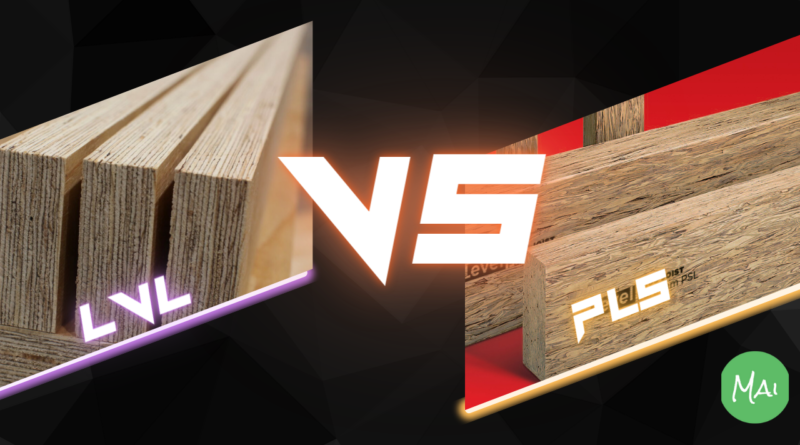Exploring the World of Engineered Wood: PSL vs LVL

When it comes to building structures that stand the test of time, the choice of materials plays a crucial role. In the realm of engineered wood, two popular options often stand out: Parallel Strand Lumber (PSL) and Laminated Veneer Lumber (LVL). Both have their unique characteristics and applications, making them favorites among architects, engineers, and builders. In this article, we’ll embark on a friendly exploration of PSL and LVL, unraveling their differences, applications, and the fascinating world they open up in the construction industry.
Getting to Know PSL – Engineered Wood
Parallel Strand Lumber, or PSL, is a high-performance engineered wood product that falls under the category of structural composite lumber. It is crafted by arranging long strands of wood in parallel alignment, bonded together with a strong adhesive. The strands used in PSL are typically made from small-diameter trees, often sourced from sustainable forestry practices.
One standout feature of PSL is its exceptional strength and stiffness. The parallel orientation of the wood strands contributes to its ability to handle heavy loads, making it a preferred choice in applications where strength is paramount. The manufacturing process involves the application of heat and pressure, ensuring a solid and durable end product.
Unveiling the Merits of PSL
1. Strength and Stability:
PSL is renowned for its high strength and stability. The parallel arrangement of strands maximizes the material’s load-bearing capacity, making it an excellent choice for structural elements in buildings.
2. Dimensional Consistency:
Builders appreciate PSL for its dimensional consistency. The manufacturing process allows for precise control over the dimensions of the final product, reducing variability and ensuring a more predictable construction process.
3. Sustainability:
PSL often gets a nod from eco-conscious builders due to its use of small-diameter trees, promoting sustainable forestry practices. Additionally, the manufacturing process minimizes waste, contributing to its eco-friendly profile.
Also Read: The Truth Revealed: Is Tubbo Gay or Straight?
Journey into the World of LVL
On the other side of the engineered wood spectrum, we find Laminated Veneer Lumber, or LVL. Like PSL, LVL belongs to the family of structural composite lumber, but its construction and characteristics set it apart.
LVL is crafted by bonding together thin veneers of wood with the grain aligned parallel to the length of the lumber. This assembly of veneers is then subjected to heat and pressure, resulting in a robust and versatile engineered wood product. The veneers used in LVL are typically sourced from high-quality logs, contributing to its premium quality.
The Allure of LVL
1. Versatility:
LVL’s versatility shines in various applications. From beams and headers to joists and rafters, LVL finds its place in both residential and commercial construction projects.
2. Predictable Performance:
Builders appreciate LVL for its predictable performance. The manufacturing process allows for stringent quality control, ensuring that each piece meets the specified standards, reducing the risk of surprises during construction.
3. High Strength-to-Weight Ratio:
LVL is celebrated for its high strength-to-weight ratio. This feature makes it an attractive option in applications where minimizing dead load is crucial, such as in long-span structures.
Also Read: LSL vs LVL – Know What is The Key Difference
The Friendly Face-Off: PSL vs. LVL
Now that we’ve acquainted ourselves with the protagonists of our story – PSL and LVL – let’s delve into a friendly face-off, exploring where each excels and which might be the better fit for specific scenarios.
1. Strength Battle:
In the strength department, both PSL and LVL hold their ground admirably. PSL, with its parallel strand arrangement, is often favored in applications where sheer strength is paramount. On the other hand, LVL’s high strength-to-weight ratio makes it a contender in scenarios where minimizing dead load is a priority.
2. Versatility Showdown:
While both materials are versatile, LVL tends to take the lead in terms of applications. Its adaptability to various construction elements, coupled with predictable performance, makes it a popular choice among builders looking for flexibility without compromising structural integrity.
3. Aesthetic Appeal:
Beyond the technicalities, there’s an aesthetic dimension to consider. PSL, with its exposed parallel strands, may appeal to those seeking a more industrial or rustic look. LVL, with its smooth veneer surface, offers a cleaner and more polished appearance.
Also Read: How Old is Rosalina? Know The Real Age of Rosalina in Mario
Applications in the Real World
As we navigate the friendly face-off, it’s essential to consider where PSL and LVL find their homes in real-world construction projects.
1. PSL’s Strongholds:
- Heavy Load-Bearing Structures: PSL’s exceptional strength makes it a go-to choice for heavy load-bearing structures like columns and beams.
- Industrial and Rustic Designs: The exposed strands in PSL lend themselves well to industrial or rustic design aesthetics, adding a touch of character to a structure.
2. LVL’s Domains:
- Long-Span Structures: The high strength-to-weight ratio of LVL makes it an ideal candidate for long-span structures, offering stability without excessive weight.
- Residential Construction: LVL’s versatility and predictable performance make it a favorite in residential construction for beams, headers, and other load-bearing elements.
Also Read: How Old is Yoshi? What is the Real Age of Yoshi in Mario
The Verdict: A Win-Win Scenario
In the end, the choice between PSL and LVL often boils down to the specific requirements of a project. The good news is that builders and architects can rest easy knowing that both options offer a win-win scenario, each bringing its unique strengths to the table.
As the construction industry continues to evolve, the friendly competition between PSL and LVL fuels innovation, pushing the boundaries of what’s possible in engineered wood. Whether you find yourself captivated by the rugged charm of exposed strands or enamored with the sleek veneer finish, both PSL and LVL promise a reliable and robust foundation for the structures of tomorrow. So, let the friendly face-off continue, and may the best lumber win in the spirit of building a better, more sustainable future.








